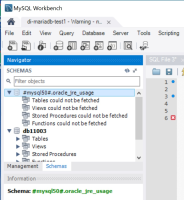Very strange... but I think I have figured out what is happening (but don't know what to do about it yet).
Take a look at the following...It appears the #mysql50# is an internal MySQL thing:
http://g33kinfo.com/info/archives/5080
Then take a look at the following... it appears that .oracle_jre_usage is a folder created by the JRE in your the user's home directory when it runs:
https://community.oracle.com/thread/3783686
I think what is happening, on Linux anyway, is that when the JRE is started by CONNECT for JNI it is running as the mysql user and therefore creating a folder called .oracle_jre_usage in the home directory of the mysql user. On centOS 7 it is in fact sitting right there alongside real database folders:
/var/lib/mysql/.oracle_jre_usage
Since its a folder it thinks its a database, and since it can't figure it out it is labeling it as incompatiable so putting the #mysql50# prefix on it. The question now is, how to prevent it from creating that when it runs, or have it place it in a different folder.
It appears to be created by the Java Usage Tracker which is turned off by default. See details here:
https://docs.oracle.com/javacomponents/usage-tracker/overview/
Since this is off by default, I'm guessing CONNECT is turning it on with a command like the following when starting Java:
java -Dcom.oracle.usagetracker.config.file=/path/usagetracker.properties MyApplication
And the path is the same directory on linux that holds the databases.
Does that make sense? Can it be fixed in time for 10.1.19?
We are excited to push this into production.
Thank you!
Bug
Major

I see nothing in CONNECT that creates such a database as "#mysql50#.oracle_jre_usage".
Without more details about this and what is done mysqldump, I am afraid I can cannot do anything about this case.